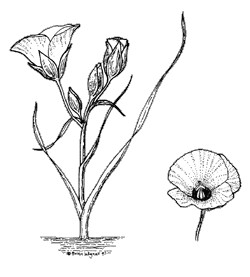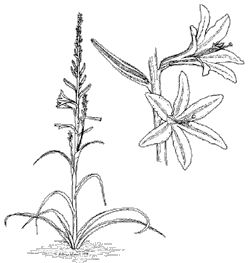Liliaceae (lily family)
At about 5000 species worldwide, the lily family is fairly large, even though several other large groups were split off into their own families in recent years. This more narrowly-defined family still includes our regionís ajo lily (desert lily), mariposa, and the true lilies of wetter climates. Former lilies that have been placed in their own families include agaves, yuccas, onions, asparagus, and the aloes.
Calochortus kennedyi
English name: desert mariposa
Spanish name: mariposa (butterfly)
Description
This is a perennial herb with only 1 to 3 small leaves that sprout from a deeply buried bulb (technically, a corm). The 1 to several flowers are about 2 inches (5 cm) across and open 1 or 2 at a time. The flowers have 3 broad red-orange or yellow petals that form an open cup. Each population blooms for about 2 weeks in late spring at desert elevations, given sufficient rainfall.
Range
It grows in heavy or rocky soils from 2000 to 6500 feet (600-2000 m) elevation, from southeastern California and southern Nevada to northern Sonora.
 |
Notes
Desert mariposa produces the most brilliant flowers in the Sonoran Desert; a single incandescent vermillion chalice can be seen from a ¼-mile (almost a km) away. The yellow-flowered form is most common at elevations above the desert. Despite their brilliance mariposas are not commonly encountered. Though their geographic range is great, individual populations are widely scattered, and they donít bloom every year.
In our region this species grows only in heavy clay soils where the small bulbs are buried deeply, a necessity resulting from their Mediterranean climate ancestry. The genus Calochortus evolved in the winter-rain habitats of the Pacific coast of North America, and most of its 60 species are extremely vulnerable to rot if they get wet during summer. The Sonoran Desertís summer rains are too brief in duration to wet clay-rich soil to the depth of the bulbs, but the slow, soaking winter rains do reach them in wet years. The bulbs behave as do the seeds of annual drought-evading species, remaining dormant for several successive years if rain is sparse.
Many other lily species also have bulbs that are deeply buried or grow in very hard soils. Protection from birds and rodents may be another advantage of this habit. We once sowed over 100,000 desert hyacinth (Dichelostemma pulchella) seeds in sandy soil in the Desert Museumís cactus garden. They germinated like grass under irrigation, but within a few years almost none remained. Iíve had the same experience at home with a variety of small bulbs in friable garden soil. One year I planted 1000 crocus bulbs, only 3 of which survived to flower. The rest were destroyed as soon as they sprouted, mostly by Curve-billed Thrashers that excavated the bulbs in search of insects. Once the bulbs were exposed, other birds and rodents ate them.
Knowing these facts about their biology is not sufficient to enable us to cultivate desert mariposas. Even though wild ones are abundant in King Canyon, only a few hundred yards (¼ km) from the Desert Museum, we have never been able to grow them on the grounds. Germination of seeds is easy, but the resulting first-year bulbs never sprout again, though they may survive several years. We donít know how to break their dormancy.
Bulbs of all Calochortus species are edible, though digging them is labor-intensive because they are typically small and deeply buried in heavy soils. A minute percentage of ground bulbs added to wheat flour imparts a more desirable texture to bread; experimental field cultivation of some species is under way.
Hesperocallis undulata
English names: Desert lily, ajo lily
Spanish name: ajo (garlic)
 |
Description
A rosette of strap-shaped, undulate leaves sprouts from a deeply-buried bulb. Spikes bearing 2-inch (5 cm) long trumpet-shaped white flowers rise above the foliage late in the spring flowering season. The spikes are usually less than a foot (30 cm) tall, but occasionally exceed 6 feet (2 m) in wet years.
Range
Desert lily is most common in loose sandy soils from the eastern Mohave Desert south through Arizona to northern Sonora and central Baja California.
Notes
This species is widespread and conspicuous when in flower. Like desert mariposa, the bulbs behave as drought-evading annual seeds, flowering only in wet years. They are also very difficult to cultivate. In sand the bulbs may be 2 feet below the surface. This deep location probably protects them from both hungry animals and the summer rains, which might otherwise rot them.










